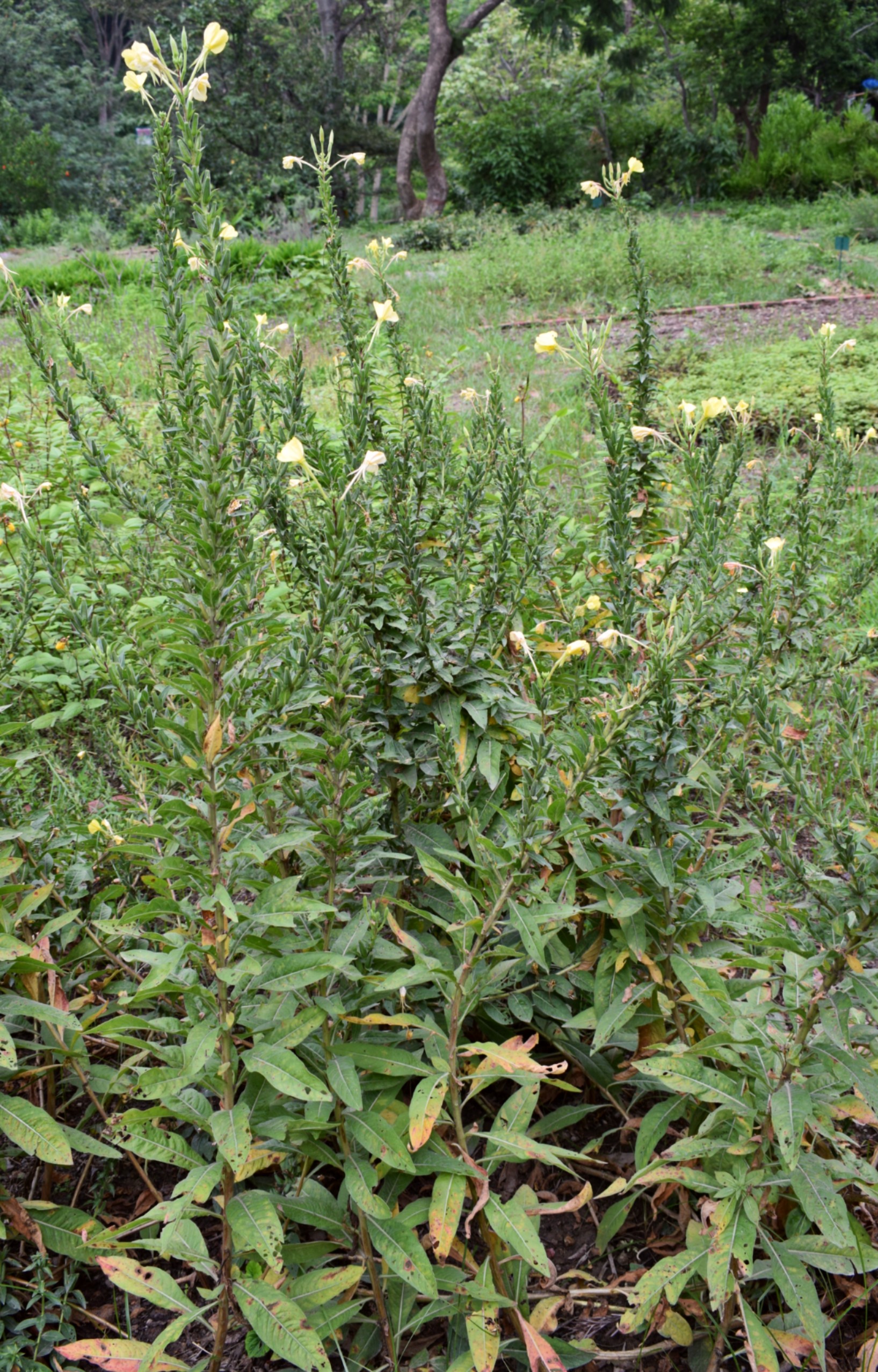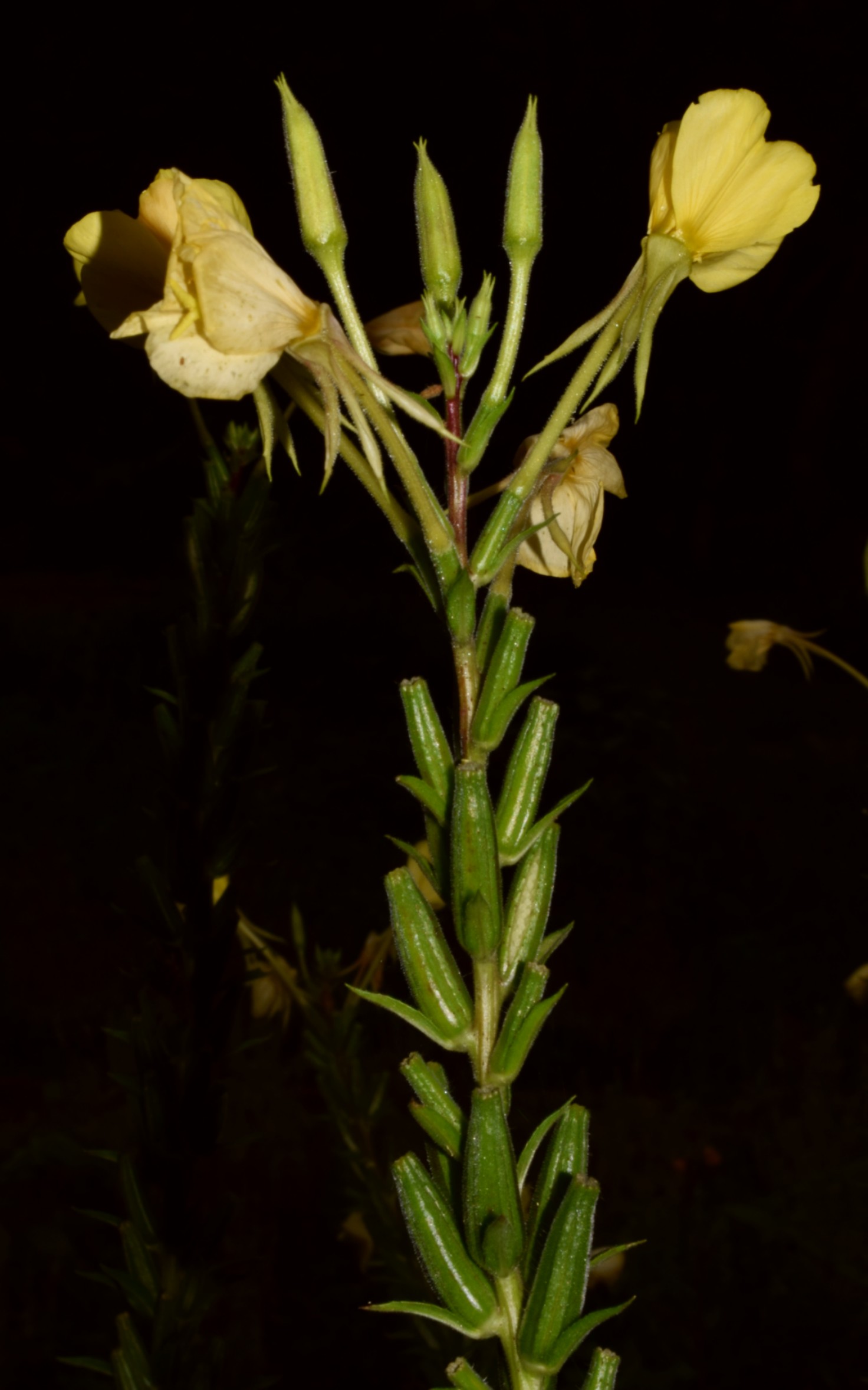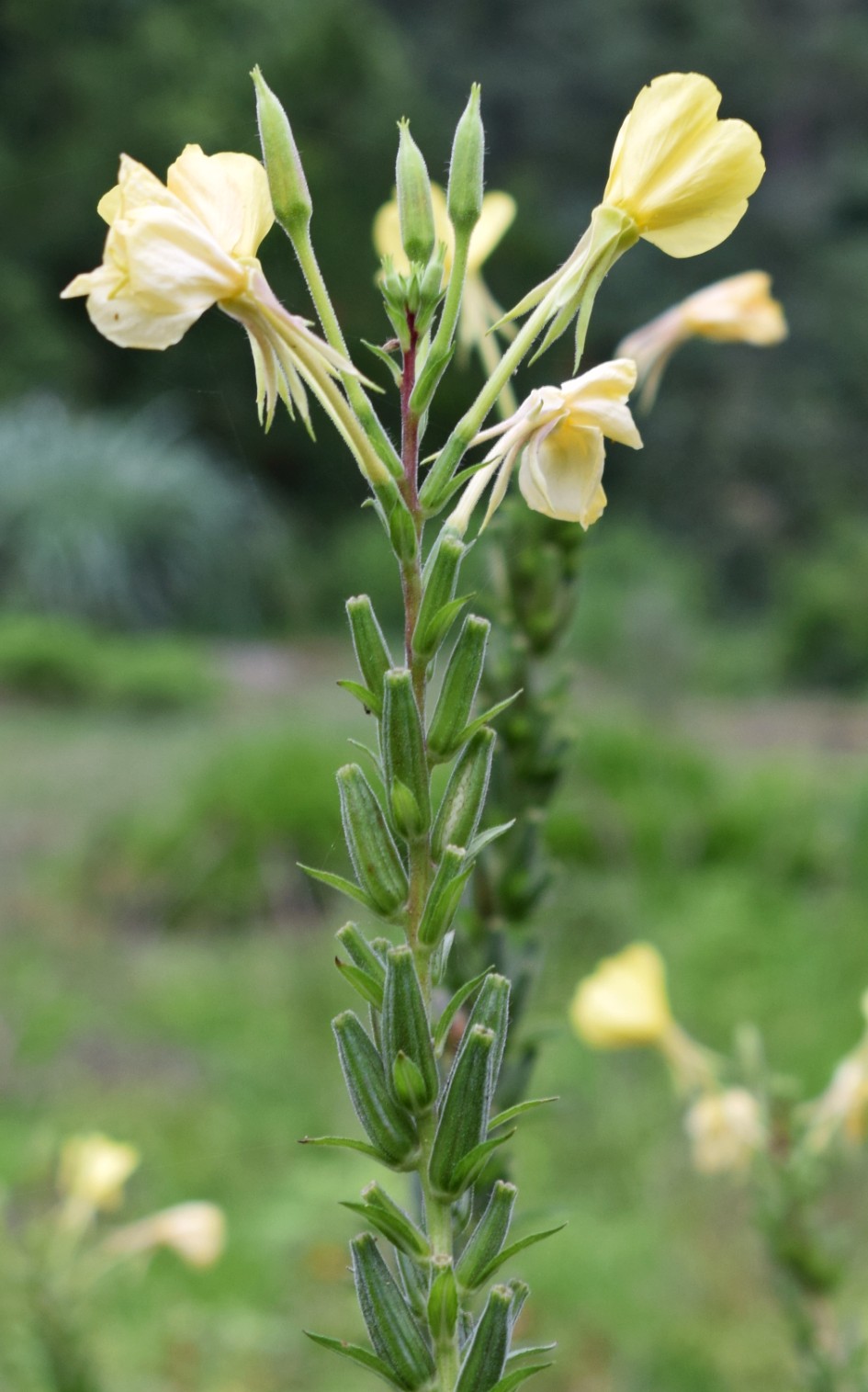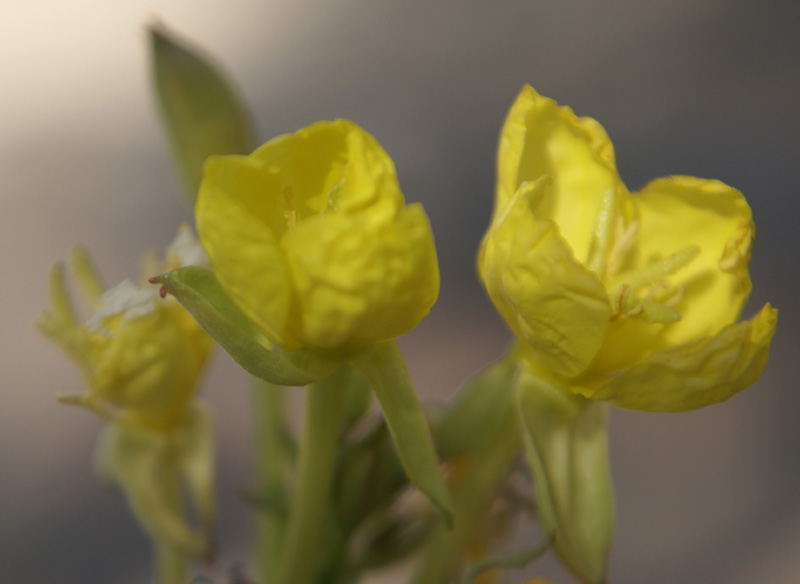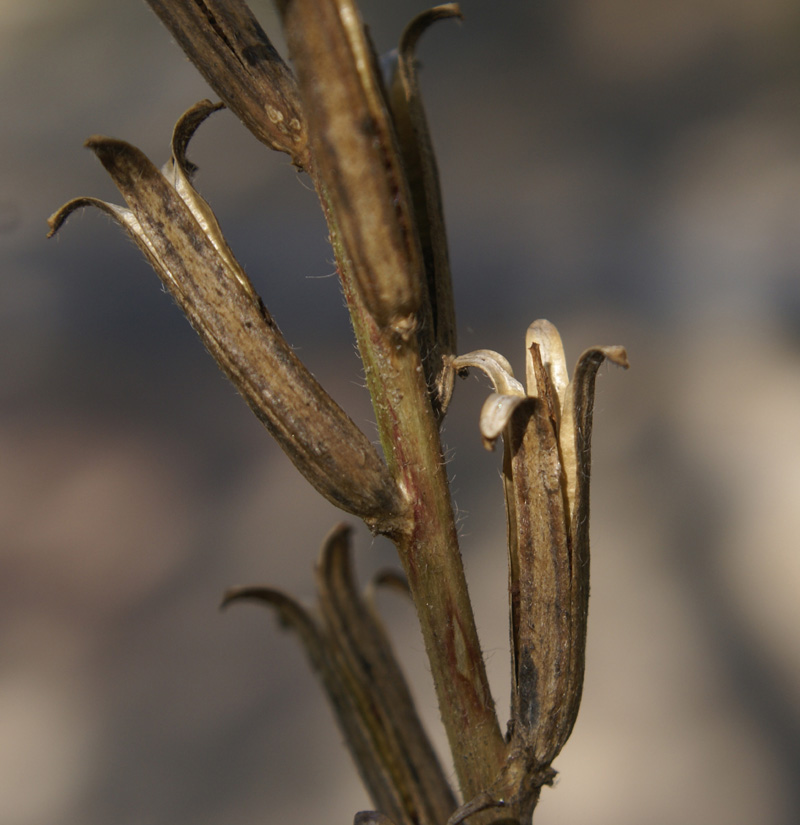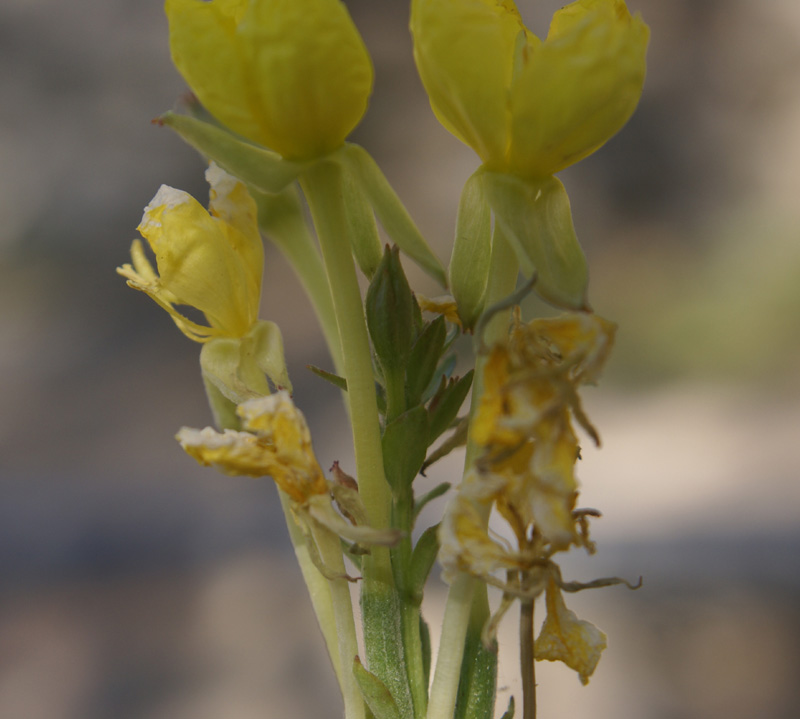|
Oenothera biennis L. (syn: Brunyera biennis (L.) Bub.; Oenothera biennis subsp. caeciarum Munz ……; Oenothera brevicapsula Bartlett; Oenothera chicaginensis de Vries ex O. Renner ..; Oenothera chicagoensis Ren. ex Cleland & Blakeslee; Oenothera chrysantha var. latifolia Spach; Oenothera communis Leveille; Oenothera furca Boedijn; Oenothera gaurodes var. brevicapsula (Bartlett) R. R. Gates; Oenothera grandifolia R. R. Gates; Oenothera graveolens Gilib.; Oenothera hirtella de Vries (ambiguous synonym); Oenothera linkiana Spach; Oenothera media Link; Oenothera muricata L.; Oenothera muricata var. latifolia Asch.; Oenothera novae-scotiae var. serratifolia R. R. Gates; Oenothera numismatica Bartlett; Oenothera paralamarckiana R. R. Gates; Oenothera parviflora var. muricata (L.) Farw.; Oenothera pratincola Bartlett; Oenothera pratincola var. numismatica (Bartl.) Gates; Oenothera purpurata Klebahn; Oenothera reynoldsii Bartlett; Oenothera rubiennis de Vries; Oenothera rubricapitata R. R. Gates (ambiguous synonym); Oenothera ruderalis Bartlett; Oenothera sabulosa Farw.; Oenothera sackvillensis R. R. Gates; Oenothera sackvillensis var. albiviridis R. R. Gates; Oenothera salicastrum de Vries; Oenothera shulliana Sturtevant; Oenothera stenomeres Bartlett; Oenothera tracyi Bartlett; Onagra biennis (L.) Scop.; Onagra chrysantha var. grandiflora Spach; Onagra europaea Spach; Onagra muricata (L.) Moench; Onagra vulgaris Spach; Pseudo-oenothera virginiana Rupr.);
USA (Alabama, Arkansas, California, Connecticut, District of Columbia, Delaware,
Florida, Georgia, Iowa, Illinois, Indiana, Kansas, Kentucky, Louisiana, Massachusetts, Maryland, Maine, Michigan, Minnesota, Missouri, Mississippi, Montana, North Carolina, North Dakota, Nebraska, New Hampshire, New Jersey, New Mexico, Nevada, New York, Ohio, Oklahoma, Oregon, Pennsylvania, Rhode Island, South Carolina, South Dakota, Tennessee, Texas, Virginia, Vermont, Washington State, Wisconsin, West Virginia), Canada (Alberta, British Columbia, Manitoba, New Brunswick, Newfoundland, Nova Scotia, Ontario, Prince Edward Isl., Quebec, Saskatchewan), Mexico (Chihuahua, Puebla), Austria (I), Belgium (I), England (I), Czech Republic (I), Slovakia (I), Denmark (I), Germany (I), Ireland (I), Switzerland (I), Netherlands (I), Hungary (I), Norway (I), Poland (I), Romania (I), Sweden (I), Portugal (I), Spain (I), France (I), Corsica (I), Sardinia (I), Sicily (I), Italy (I), Slovenia (I), Bosnia & Hercegovina (I), Croatia (I), Serbia (I), Kosovo (I), Macedonia (I), Montenegro (I), Albania (I), Bulgaria (I), Greece (I), Estonia (I), Latvia (I), Lithuania (I), Moldavia (I), European Russia (I), Belarus (I), Ukraine (I), Kyrgyzstan (I), Crimea (I), Northern Caucasus (I), Georgia [Caucasus] (I), Siberia (I), Russian Far East (I), Uzbekistan (I), Tajikistan (I), Kazakhstan (I), Japan (I) (Hokkaido (I), Honshu (I), Shikoku (I), Kyushu (I)), China (I) (Anhui (I), Guangdong (I), Guangxi (I), Guizhou (I), Hebei (I), Henan (I), Hubei (I), Hunan (I), Jiangsu (I), Jilin (I), Liaoning (I), Sichuan (I), Yunnan (I)), Taiwan (I), Korea (I), Costa Rica (I), Chile (I), Argentina (I), S-Brazil (I), Australia (I) (Queensland (I)), South Africa (I), Lesotho (I), European Turkey (I), Iran (SW-Iran (I), EC-Iran (I)), Azores (I) (Sao Miguel Isl. (I), Terceira (I), Sao Jorge (I), Pico (I), Corvo Isl. (I)), Madeira (I) (Madeira Isl. (I)), Canary Isl. (I) (Tenerife (I)), Tunisia (I), ?Algeria (I), Morocco (I), New Zealand (I), Bhutan (I), Burma (I), India (I), Pakistan (I), Sri Lanka (I) as per Catalogue of Life; As per efi thread:
1. In Oenothera glazioviana Petals are much larger 3-5cm long while in Oenothera biennis petals are only upto 2.5cm long.
2. These plants are much taller upto 6 feets and according to FOC stem is upto 150cm in O. glazioviana while plants are much longer upto 200cm in O. biennis. 3. Stigma is surrounded by anthers in O. biennis Oenothera biennis submission : 6 posts by 4 authors. Attachments (5)- around 400 kb each. Oenothera biennis
Common Evening Primrose
Family – Onagraceae
Photographed in cultivation at Dr Yashwant Singh Parmar University of Horticulture and Forestry, Solan, Himachal Pradesh
Dated – 11 July 2018
very important oil source. medicinal. love your pictures Thanks, …, We do not have this species so far in efi. Simlar plants in efi, has been identified as Oenothera glazioviana (Introduced)
Pl. check.
look up http://www.efloras.org/florataxon.aspx?flora_id=2&taxon_id=122735#KEY-1-6 for differentiation Thanks … I have already gone through that page. The reasons for this plant to be O. biennis are – It was already mentioned as O. biennis in the University Herbal garden so they must have corfirmed it.
Some other differences are-
1. In Oenothera glazioviana Petals are much larger 3-5cm long while in Oenothera biennis petals are only upto 2.5cm long. 2. These plants are much taller upto 6 feets and according to FOC stem is upto 150cm in O. glazioviana while plants are much longer upto 200cm in O. biennis. 3. Stigma is surrounded by anthers in O. biennis Oenothera drummondii from Manali: A relook : 6 posts by 3 authors.
Last year I had uploaded these photographs from Manali identified as O. drummondii, largely influenced by the tips of dehiscing capsules appearing expanded and the fact that similar plant from Kashmir has often been reported as O. drummondii.
The plant from Manali in on FOI
After seeing several plants in Kashmir in June this year and studying them critically I came to the conclusion that Kashmir plant is O. glazioviana (formerly known as O. erythrosepala) as flowers are large in size, inflorescence several-flowered, capsule clearly narrowed towards tip, purple dots on stem and calyx tinged purple (hence erythrosepala). I have uploaded it separately today. O. drummondii, I now realize is a much different coastal plant rarely ascending above 400 m, decumbent patch-forming, capsules enlarged towards apex and inflorescence few flowered with single uppermost flower visible each day (perhaps … may find and upload this for us):
Could it then be O. biennis, kindly compare and give your opinion. After comparing images at Oenothera glazioviana and of Oenothera biennis at
I feel posted images are more closer to images at Oenothera glazioviana
Can it be Oenothera biennis as per discussions in your post ? Yes …, it is likely Oenothera biennis. however i am not entirely sure as we have to look at the petals size and stigma etc. to get sure. I think this is from wild unlike my O. biennis which is from cultivation but i know that there is one Oenothera sp. which has escaped into wild in Kullu district that i had also encountered last year in September, this year i will study that plant to find out its correct identity. Till then you may treat it as O. biennis.
Oenothera drummondii from Manali HP : 3 posts by 2 authors. Attachments (3)
Uploading Oenothera drummondii Hook. from Manali, HP Photographed on 23 October, 2009
After comparing images at Oenothera glazioviana and of Oenothera biennis at
I feel posted images are more closer to images at Oenothera glazioviana
Oenothera glazioviana for sharing and validation:: NS March 2020-01 : 2 posts by 2 authors. Attachments (7) Please find some pics recorded from Nauni campus of Dr. YSP University of Horticulture and Forestry, Solan, Himachal Pradesh..
I hope it is rightly identified as Oenothera glazioviana..
I think Oenothera biennis L. as per comparative images and keys at Oenothera
Plant For ID : California : 06JAN15 : AK-3 : 6 posts by 4 authors. Attachments (1) A beautiful rosette.. clueless on id..
Its the first year leaf rosette of dark or black mullein
verbascum nigrum some people eat the first leaves other plant it for the bright stalks of yellow flowers You are really amazing!
Thanks a lot for the id.
kindly inform on what characters you identify the plant as Verbascum nigrum I do not agree with your identification the rosette like leaves are the characters of some different plant and needs correct identification.
I gave my opinion
if you disagree the ball is in your court
you prove it that its not…
I am not a botnaist so I would have to depend on your knowledge for the details if can give us some To me Oenothera biennis looks a better choice
Other references:
|
Oenothera biennis (Introduced)
Updated on December 24, 2024

